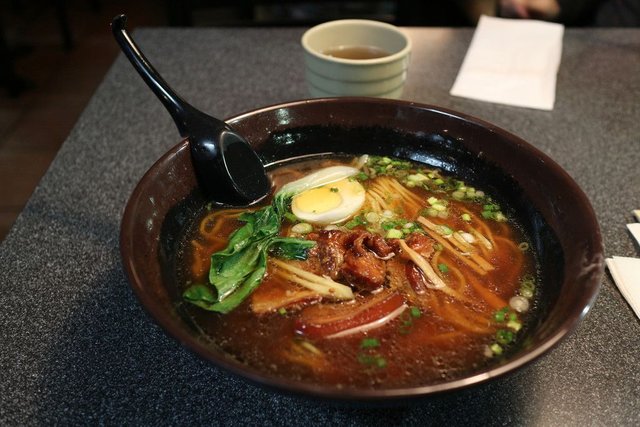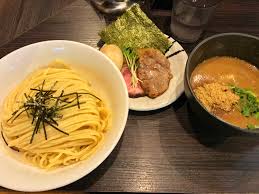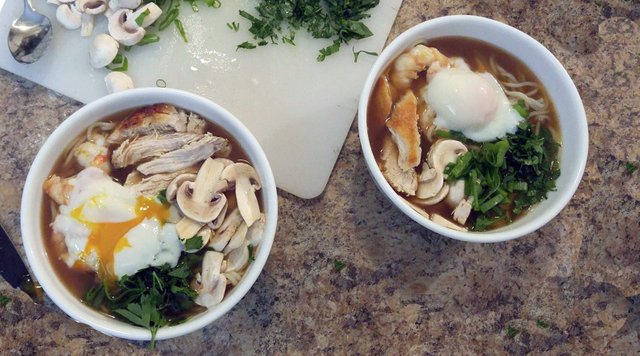Spotlight Writing Contest #3: The Home Slice Guide to Epic Ramen
The Home Slice Guide to Epic Ramen
Ramen is a bowl of noodle-soup served with meats and vegetables. While this statement is true, ramen is more than the sum of its parts. Instant ramen has became a food staple and the demand has only grown. Many in the culinary world have taken notice. The first time it was introduced to the rest of the world was in the form of instant noodles. As of 2010, around 95 billion in instant noodles are eaten worldwide every year. What we didn’t know for a long time was, that they weren't the real deal. As food lovers and chefs traveled across the globe they began to introduce some the best dishes they found. Then we learned more about the real ramen
Ramen history
There still are debates whether ramen noodles originated in Japan or in China. Either way, this dish has been around since the early 1900s. The history of ramen is ambiguous. The most popular theories is ramen was first sold in Tokyo by Chinese food carts and restaurants. They used Soba noodles ever since they been called Shina Soba.In the next few years, Shina Soba became very popular with the Japanese people and was available at several Japanese restaurants with local ingredients.
With World War 2, came cheap flour from the US to Japan. This meant more noodles, which made dishes like ramen cheap. With the Japanese troops coming back home from China and being more familiar with Chinese cuisine, the locals saw more and more Chinese based food shops being set up everywhere. Shina Soba became a commonly consumed cheap food.
The Rise of Ramen
1958 saw the first instant ramen noodles, a packaged version of the popular Shina Soba. Momofuko Ando creator of instant ramen and Nissin Foods was the first company to introduce this food. Trying to help his people during a post-war food crisis.
By the 1970s, Ramen made a big splash in the US market and became a household product. It became popular with college students and the working class alike. It was inexpensive and easy to make.
With the rise of ramen through pop culture and the social media, Japan’s ramen shops multiplied quickly. Today, there are over 6000 Ramen shops in Tokyo. Some of these shops serve every possible type of ramen you can think of even the instant kind. Ramen remains one of the most talked about foods and enjoyed by millions of people every day.
As Japanese food went global, so did ramen, it has had an impact around the globe. It has become more than a quick relief for hunger pangs. Some of the best Japanese restaurants in the US serve delicate broths with local produce. Ramen is also one of the most photographed foods on social media.
Types of Ramen
As simple as the dish may seem, ramen has become a comfort food. Something that you would want to have on a cold autumn evening or in the middle of a winter’s night. Ramen is a versatile comfort food and its ingredients can be changed to each persons taste.
Broth flavors
Broth is like the soul of ramen. Ramen broth is essentially made from chicken or pork bones. Sometimes a mixture of the two. The flavors may vary. Some call for dashi (seaweed), which is a broth made from dried tuna or anchovies and cooked with konbu( seaweed). This is then mixed with the meat bone broth. There are other recipes, which call for seafood broths as well.
There are four main ramen flavors that affect the overall taste of a ramen bowl. Shio, Shoyu, Tonkotsu, and Miso are the primary flavor profiles. Shio us more traditional its way and is more on the saltier side. It is very light in color and flavor, which makes it very popular in the West. Shoyu is a soy-based broth. Shoyu itself means soy. Soy is used in place of salt. The soy used in Shoyu has other secret ingredients as well to make a flavorful broth. This kind does not have pork in it. It is a lighter broth, which is salty as well as a tad sweet. Then there’s Miso. Miso is made with aged and fermented soybeans. Miso paste gives the broth a more savory taste. It gives the broth an opaque color and a more complex flavor, unlike Shio or Shoyu. Miso paste is to be used sparingly and only stirred towards the end of the broth making. Tonkotsu is made with ground pork bones, which are cooked for over 12 hours. This makes the broth more gelatinous in texture.
Noodles
These are some variations of noodles used in ramen. The Chinese kind was originally egg noodles. The Japanese worked on creating different types of noodles using wheat. The most popular noodle is now the alkaline noodle, The basic one made with wheat flour, water, salt, and kansui( food grade lye) Kansui is what distinguishes ramen from other noodles. It gives the noodles a light yellow color and a sturdier slurpable texture. Noodles used in ramen are different shapes and sizes. They can be thin, thick, curly, straight, and wrinkled.
Different ingredients and toppings
If broth is the soul of ramen, toppings are its personality and traits. The most popular meat served with ramen is braised pork belly, served in slices, known as chashu. Another kind of meat topping is kakuni, which are braised pork cubes. Customers varied preferences have given way to other meats like chicken, but pork remains popular.
Topping choices include nori (dried seaweed), menma (fermented bamboo shoots), fish paste, moyashi (beans sprouts), tamago (marinated, soft-boiled or a hard-boiled egg), negi (chopped or shredded leeks), and spring onions. Some ramen bowls have vegetables like sliced carrots, bok choy, mushrooms, and corn among others. Another topping is butter, which adds depth to the dish. There are several regional variants depending on the geography and vegetation grown in the region.
Regional ramen
Ramen became a common food in various Japanese islands and regions. These regions created their own versions of this noodle-phenomenon.
Tokyo-style ramen
Tokyo-style ramen is predominantly shoyu flavored with a touch of dashi. Chicken stock and shoyu are mixed together and dashi added to it. This unique Tokyo-style ramen is with chashu, kamaboko, and half an egg. Finished with preserved bamboo shoots.
Tonkotsu Ramen-Hakata-style ramen
Tonkotsu Ramen, specialty of Hakata in Fukuoka, known for its distinctive aroma. This tonkotsu ramen comes from the warmer side of the Kyushu Island of Japan, which is known for its pig farming. The biggest city on the island is Fukuoka and Hakata is one its districts. In this style of ramen, you get chashu, egg, scallion, pickled ginger, crushed garlic, pickled mustard greens, and sesame seeds. It is very flavourful and has become a destination for travelers.
Kitakata-style ramen hails from the city of Kitakata in Northern Honshu. The city is the highest number of ramen shops in the world. This style of ramen comes with thick and flat noodles with a shoyu flavored broth, which is made with pork broth, dashi, and anchovies. A slice of pork, fish cake, and leeks.
Sapporo-style ramen
Sapporo-style ramen comes from Sapporo, which is the capital of Hokkaido. Sapporo-style ramen is rich with miso, which is a product of Sapporo invention. Miso was first used in ramen in Sapporo by a chef. The broth consists of chicken or pork bones and then combined with miso. This makes for a rich and savory broth perfect for winters. Today, this style of ramen is topped with fresh local produce like leeks, corn, roasted scallion, and even seafood.
Onomichi ramen
Onomich ramen comes from Onomichi in Hiroshima. This one too is a shoyu based ramen flavored with dashi. This style of ramen is made with seafood broth. The noodles are thin and straight with chashu, scallions, menma, and some pork fat for flavor.
Hokkaido-style ramen
Hokkaido-style ramen, also called Asahikawa ramen, comes from Hokkaido. This style of ramen is oily and has a shoyu based broth. Its noodles are thin and wavy. This ramen is topped with scallions, chashu, menma, and egg. It is a flavorful ramen and light on the stomach.

Tsukemen
Tsukemen has its own rich and thick story. If ramen is the perfect choice during cold seasons, tsukemen is the savior for noodle-craving tummies on hot, summer days. Tsukemen is served with a cold noodle separated from the sauce. The way to eat tsukemen is simple, just take an ample amount of noodle then dipped it in the sauce. With that, anybody can satisfy their craving for noodle without immersing their tongues into a hot meal.

Eating ramen
Ramen is traditionally eaten with chopsticks and the noodles and broth is slurped by lifting the bowl up to your mouth. While in Japan, it is perfectly acceptable and in fact encouraged to make a slurping sound. Ramen should be eaten right away. Otherwise, the noodles become soggy and the greens wilt.
There are several more local regional styles of ramen. That’s the beauty of adapting to the local produce and culture. Ramen became a canvas for chefs who experimented with food. As a result, we saw a boom in the ramen world across the globe. In the more recent years, thanks to social media, more information is out there. Food-loving people like to post pictures of ramen across platforms. This has made dishes like ramen more accessible and popular among modern restaurant goers who are digging into traditional pasts of food culture,but it has also evolved with time. Today, you will find curry ramen and ramen with all sorts of modern noodles.
People love ramen for many reasons. From originating in China and crossing over to Japan, it was a common food in the 1900s. Then came the instant ramen noodles, when anyone could cook a bowl for themselves at home in just a couple of minutes. It has become a dish that people turn to for comfort, to celebrate with, and to simply enjoy with friends.
If you would like to make homemade ramen here is my recipe.
Noodles
2 Cups flour
½ Cup warm water
1 ½ tsp Kansui (Alkaline water)
Add all ingredients to mixer, allow to mix until the dough comes together. This is a very stiff dough, Knead by hand to form a ball, this is a very stiff dough wrap in plastic wrap. Set aside for at least 2 hr. Remove the plastic wrap, divide dough in half. Flatten the dough. With pasta maker set to 1. Roll dough through folding and putting it through twice.then run it through number 2,then3,then 4. You should have long stripes of dough now. Put the long strips one at a time through pasta cutter.flour the counter and noodles to make sure they don't stick together
Kansui
Kansui alkaline water
Making baked baking soda is easy.
Preheat oven to 250 degrees F (120 C).
Put foil down on a cookie sheet ,add baking soda on and bake for 1 hour.
The baking soda will lose about one-third of its weight and you’ll gain a stronger alkali.
Do not touch it with your bare hands. It will cause irritation to sensitive skin.
Keep dry protected in clearly labeledl Glass jar
Ramen Broth
This is a recipe my own taste and is not as traditional as others
4 lbs Chicken backs and necks, Chicken wings make excellent broth as well.
4 Lbs Pork bones I prefer the spine bones.
1-2 Onions
1 Whole head of Garlic
Large hand full of scallions, chopped
2 Cups Mushrooms shitake or oyster mushrooms
1 Bay leaf (not traditional)
Some people rinse the bones and blanch them to make the broth lighter. I dont do that because i like the flavour better.
Get large pot big enough to fit all the ingredients. Put all ingredients into pot and cover with water. Bring to a boil. Lower heat, cover and allow to simmer for 24hrs. This sounds excessive but it takes time for the collagen to breakdown. Strain broth.
From this stock you can add flavours depending on your taste and which kind of ramen you love. I make a quazi Tonkotsu ramen.
Common Seasonings: Dashi, Soy Sauce, anchovies,Scallions,Miso,Garlic oil,Fish cake,Leek,Sesame seeds,Sesame oil Kombu
Topping: Perfect soft-boiled, Chashu, Enoki,Scallions,seaweed, fried Garlic slices. Many many more. Find your perfect flavour
Ta-Da. Here is my Ramen

Word Count: 2066
If you enjoyed this post, please help me win the Spotlight Writing Contest
Click Here and Reply to my Comment with "+1"
Wow, didn't realize I could make my own ramen noodles with my pasta maker. Sounds kinda simple to make alkaline water. Definitely will be doing this very very soon. Thanks so much these recipes:)
Yeah it's pretty easy. Toughest part is getting the dough mixed. I think with out a mixer it would be a real workout. Thanks for the upvote!
I love noodles and when you make them yourself, even better. Your history also was awesome. So it was definitely worth my upvote and I hope you get a lot more :)
Thank you so much. I enjoyed the research.
When you make them post a picture 💯
Congratulations @home-slice! You have completed some achievement on Steemit and have been rewarded with new badge(s) :
Click on any badge to view your own Board of Honor on SteemitBoard.
For more information about SteemitBoard, click here
If you no longer want to receive notifications, reply to this comment with the word
STOP